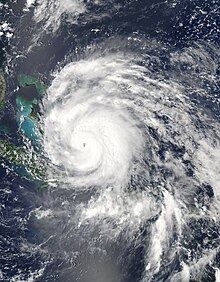
Back إعصار آيرين (2011) Arabic Айрын (ураган) Byelorussian Huracà Irene Catalan Orkanen Irene Danish Hurrikan Irene (2011) German Uragano Irene Esperanto Huracán Irene Spanish Irene (orkaan) Estonian Irene urakana Basque توفند آیرین Persian
 Irene at peak intensity over the southern Bahamas on August 24 | |
| Meteorological history | |
|---|---|
| Formed | August 21, 2011 |
| Extratropical | August 28, 2011 |
| Dissipated | August 30, 2011 |
| Category 3 major hurricane | |
| 1-minute sustained (SSHWS/NWS) | |
| Highest winds | 120 mph (195 km/h) |
| Lowest pressure | 942 mbar (hPa); 27.82 inHg |
| Overall effects | |
| Fatalities | 58 (49 direct, 9 indirect) |
| Damage | $14.2 billion (2011 USD) |
| Areas affected | Lesser Antilles, Greater Antilles, Lucayan Archipelago, East Coast of the United States, Atlantic Canada |
| IBTrACS | |
Part of the 2011 Atlantic hurricane season | |
Hurricane Irene was a large and destructive tropical cyclone which affected much of the Caribbean and East Coast of the United States during late August 2011. The ninth named storm, first hurricane, and first major hurricane of the 2011 Atlantic hurricane season, Irene originated from a well-defined Atlantic tropical wave that began showing signs of organization east of the Lesser Antilles. Due to development of atmospheric convection and a closed center of circulation, the system was designated as Tropical Storm Irene on August 20, 2011. After intensifying, Irene made landfall in St. Croix as a strong tropical storm later that day. Early on August 21, the storm made a second landfall in Puerto Rico. While crossing the island, Irene strengthened into a Category 1 hurricane. The storm paralleled offshore of Hispaniola, continuing to slowly intensify in the process. Shortly before making four landfalls in The Bahamas, Irene peaked as a 120 mph (190 km/h) Category 3 hurricane.
Thereafter, the storm slowly leveled off in intensity as it struck the Bahamas and then curved northward after passing east of Grand Bahama. Continuing to weaken, Irene was downgraded to a Category 1 hurricane before making landfall on the Outer Banks of North Carolina on August 27, becoming the first hurricane to make landfall in the United States since Hurricane Ike in 2008. Later that day, the storm re-emerged into the Atlantic from southeastern Virginia. Although Irene remained a hurricane over water, it weakened to a tropical storm while making yet another landfall in the Little Egg Inlet in southeastern New Jersey on August 27. A few hours later, Irene made its ninth and final landfall in Brooklyn, New York City. Early on August 29, Irene transitioned into an extratropical cyclone while striking Vermont, after remaining inland as a tropical cyclone for less than 12 hours.
Throughout its path, Irene caused widespread destruction and at least 49 deaths. Damage estimates throughout the United States are estimated near $13.5 billion, making Irene one of the costliest hurricanes on record in the country. In addition, monetary losses in the Caribbean and Canada were $830 million and $130 million respectively for a total of nearly $14.2 billion in damage.[1][2]
- ^ Fieser, Erza (August 25, 2011). "Hurricane Irene barrels toward US as Caribbean islands take stock of damage". The Christian Science Monitor. Archived from the original on August 26, 2011. Retrieved September 20, 2011.
- ^ Telling the Weather Story (PDF) (Report). Insurance Bureau of Canada. June 4, 2012. Archived (PDF) from the original on June 9, 2015. Retrieved July 19, 2015.